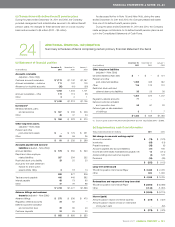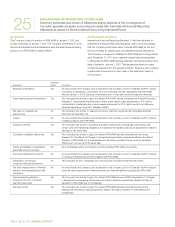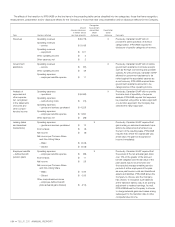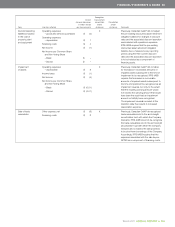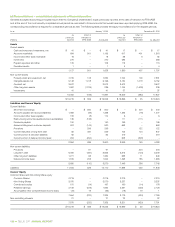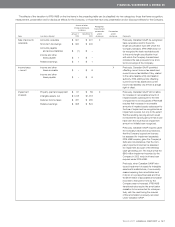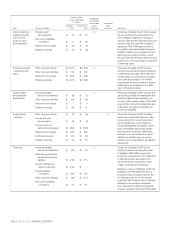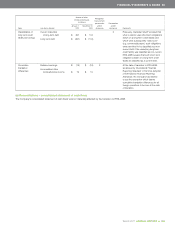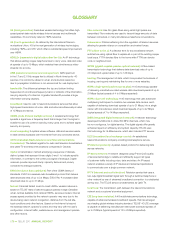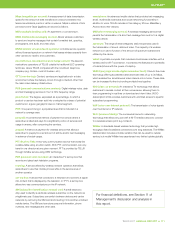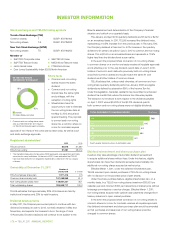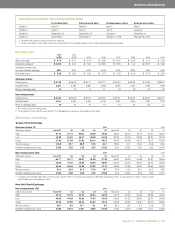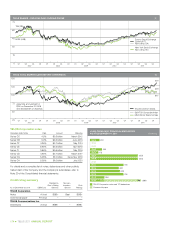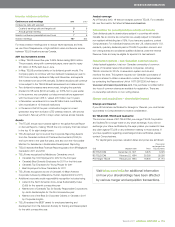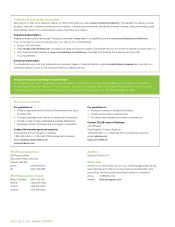Telus 2011 Annual Report Download - page 174
Download and view the complete annual report
Please find page 174 of the 2011 Telus annual report below. You can navigate through the pages in the report by either clicking on the pages listed below, or by using the keyword search tool below to find specific information within the annual report.170 . TELUS 2011 ANNUAL REPORT
3G (third generation): Describes wireless technology that offers high-
speed packet data mobile wireless Internet access and multimedia
capabilities. 3G commonly refers to HSPA networks.
4G (fourth generation): As defined by the International Telecom-
munications Union, 4G is the next generation of wireless technologies,
including HSPA+ and LTE, which offers a substantial speed improvement
over HSPA.
ADSL2+ (asymmetric digital subscriber line 2+): An IP technology
that allows existing copper telephone lines to carry voice, data and video
at speeds of up to 19 Mbps, which enables three simultaneous video
streams into a home.
AWS (advanced wireless services) spectrum: AWS spectrum
in the 1.7 and 2.1 GHz ranges that is utilized in North America for 4G
services. It is commonly utilized in urban and suburban areas but,
due to propagation limitations, is not economical for rural deployment.
bandwidth: The difference between the top and bottom limiting
frequencies of a continuous frequency band, or indicator of the information-
carrying capacity of a channel. A greater bandwidth provides a larger
information-carrying capacity.
broadband: Used to refer to telecommunications services that allow
high-speed transmission of voice, data and video simultaneously at rates
of 1.5 Mbps and above.
CDMA (code division multiple access): A wireless technology that
spreads a signal over a frequency band that is larger than the signal to
enable the use of a common band by many users and to achieve signal
security and privacy.
cloud computing: A system where software, data and services reside
in data centres accessed over the Internet from any connected device.
CRTC (Canadian Radio-television and Telecommunications
Commission): The federal regulator for radio and television broadcasters,
and cable-TV and telecommunications companies in Canada.
digital: A transmission method employing a sequence of discrete,
distinct pulses that represent binary digits 0 and 1 to indicate specific
information, in contrast to the continuous signal of analogue. Digital
networks provide improved clarity, capacity, features and privacy
compared to analogue systems.
EVDO (evolution data optimized): Part of the CDMA family of
standards, EVDO is a wireless radio broadband protocol that delivers
data download rates of up to 2.4 Mbps. EVDO Rev A increased data
download rates to up to 3.1 Mbps.
fastest: Canada’s fastest coast-to-coast HSPA+ wireless network is
based on TELUS’ tests of data throughput speeds in large Canadian
urban centres available from national HSPA+ service providers. Internet
access speed provided by the network operator may vary due to the
device being used, network congestion, distance from the cell site,
local conditions and other factors. Speed on the Internet is beyond
the wireless network operator’s control and may vary with the user’s
configuration, Internet traffic, website server and management policies,
and other factors.
fibre network: Hair-thin glass fibres along which light pulses are
transmitted. Fibre networks are used to transmit large amounts of data
between computers or many simultaneous telephone conversations.
forbearance: Policies refraining from the regulation of telecom services,
allowing for greater reliance on competition and market forces.
FTTx (fibre to the x): A collective term for any broadband network
architecture using optical fibre to replace all or part of the existing copper
local loops. FTTH denotes fibre to the home while FTTN can denote
node or neighbourhood.
GPON (gigabit-capable passive optical network): A fibre-based
transmission technology that delivers data download rates of up to
2.5 Gbps and upload rates of up to 1.25 Gbps.
hosting: The management of data, which incorporates the business of
housing, serving and maintaining files for one or more websites.
HSPA+ (high-speed packet access plus): A 4G technology capable
of delivering manufacturer-rated wireless data download speeds of up to
21 Mbps (typical speeds of 4 to 6 Mbps expected).
HSPA+ dual-cell technology: A 4G technology that uses advanced
multiplexing techniques to combine two wireless data carriers, each
capable of delivering download speeds of up to 21 Mbps, into a single
carrier with manufacturer-rated download speeds of up to 42 Mbps
(typical speeds of 7 to 14 Mbps expected).
iDEN (integrated digital enhanced network): A network technology
developed by Motorola to utilize 800 MHz channels, which may
be non-contiguous, for digital service. The digital signals offer greatly
enhanced spectrum efficiency and system capacity. TELUS uses
this technology for its Mike service, which also includes PTT service.
ILEC (incumbent local exchange carrier): An established
telecommunications company providing local telephone service.
IP (Internet protocol): A packet-based protocol for delivering data
across networks.
IP-based network: A network designed using IP and QoS (quality
of service) technology to reliably and efficiently support all types
of customer traffic including voice, data and video. An IP-based
network enables a variety of IP devices and advanced applications
to communicate over a single common network.
IP TV (Internet protocol television): Television service that uses a
two-way digital broadcast signal sent through a switched telephone or
other network by way of streamed broadband connection to a dedicated
set-top box. The TELUS service is trademarked as Optik TV.
local loop: The transmission path between the telecommunications
network and a customer’s terminal equipment.
LTE (long-term evolution): A 4G mobile telecommunications technology,
capable of advanced wireless broadband speeds, that has emerged
as a leading global wireless industry standard. TELUS’ 4G LTE coverage
is capable of delivering manufacturer-rated peak download speeds of
up to 75 Mbps (typical speeds of 12 to 25 Mbps expected).
GLOSSARY



